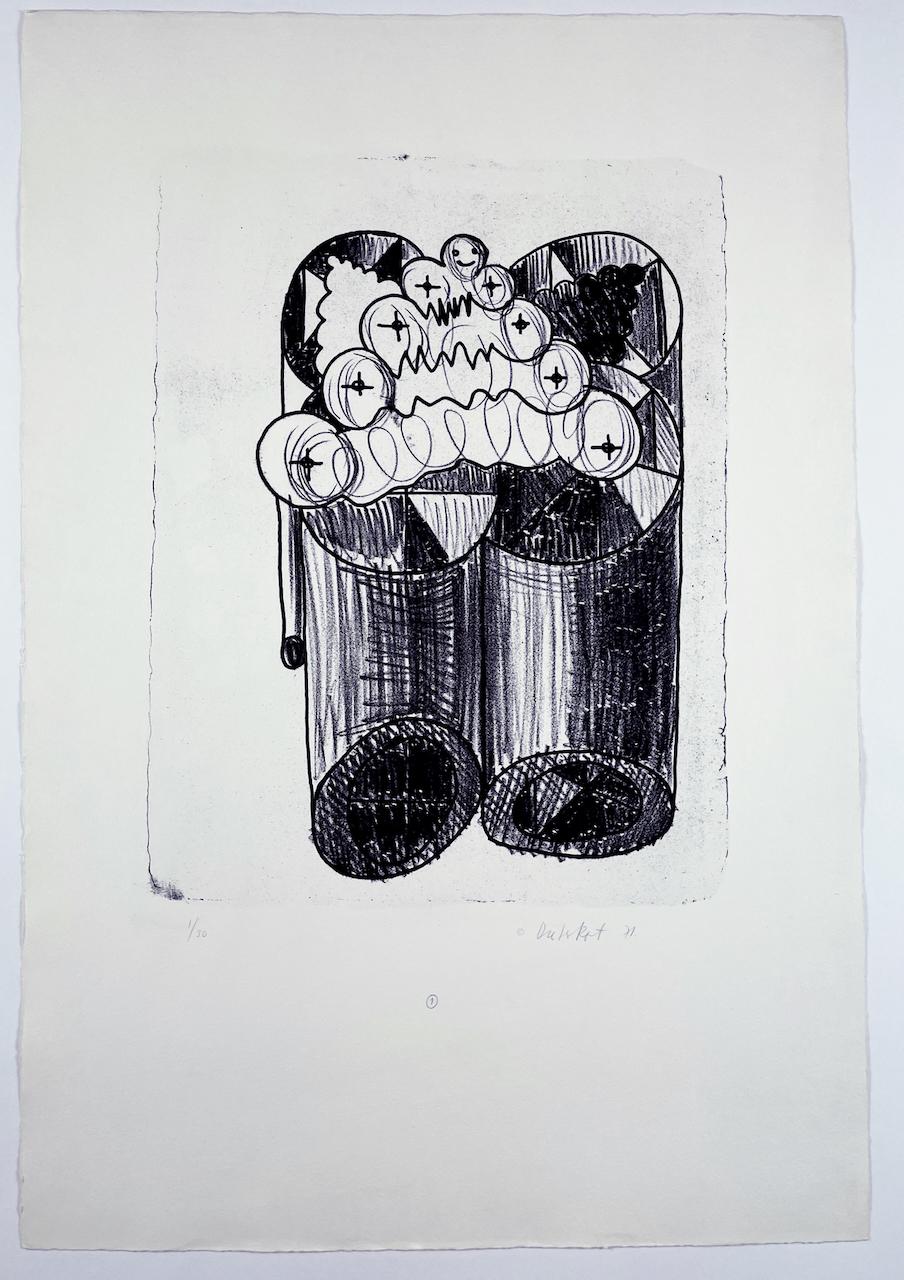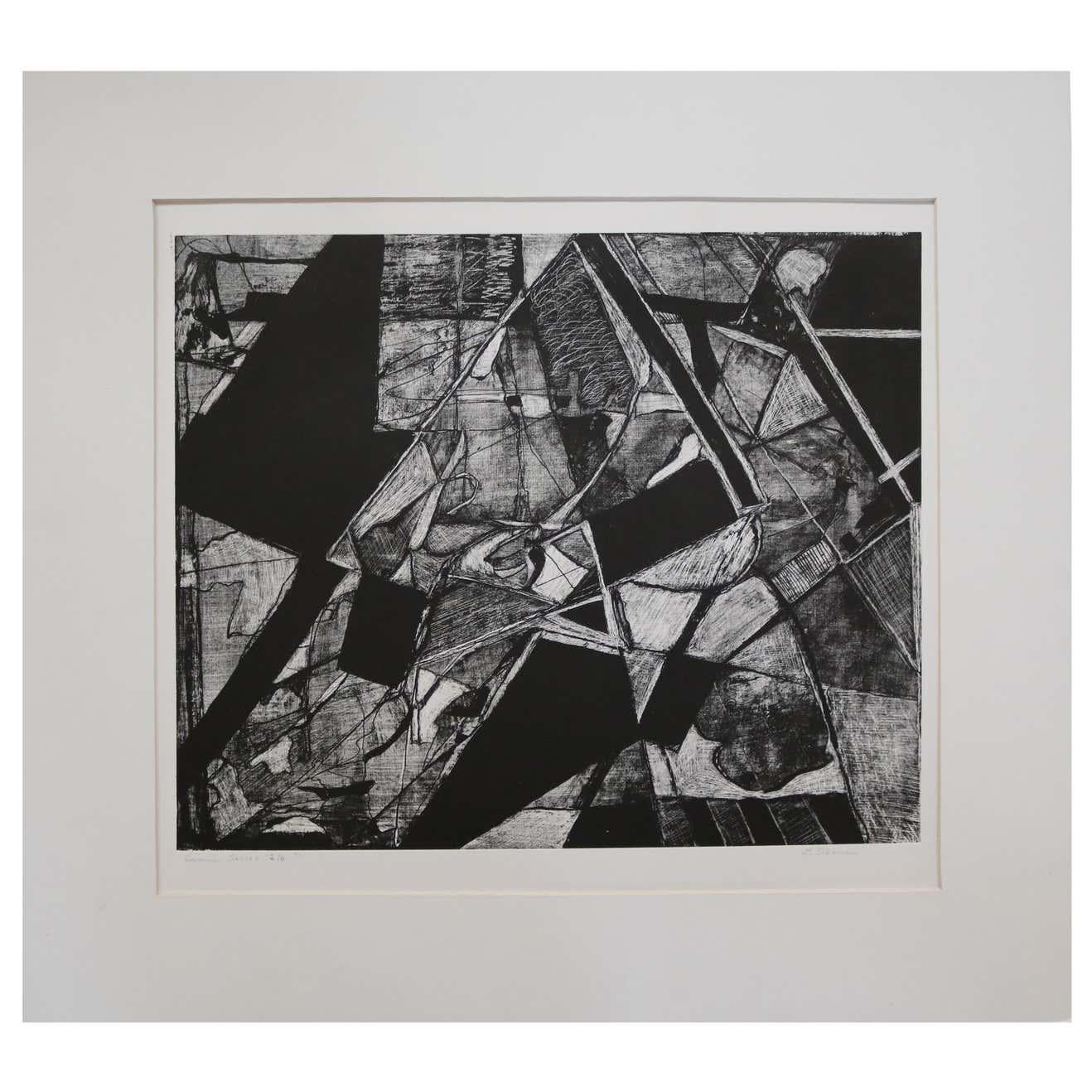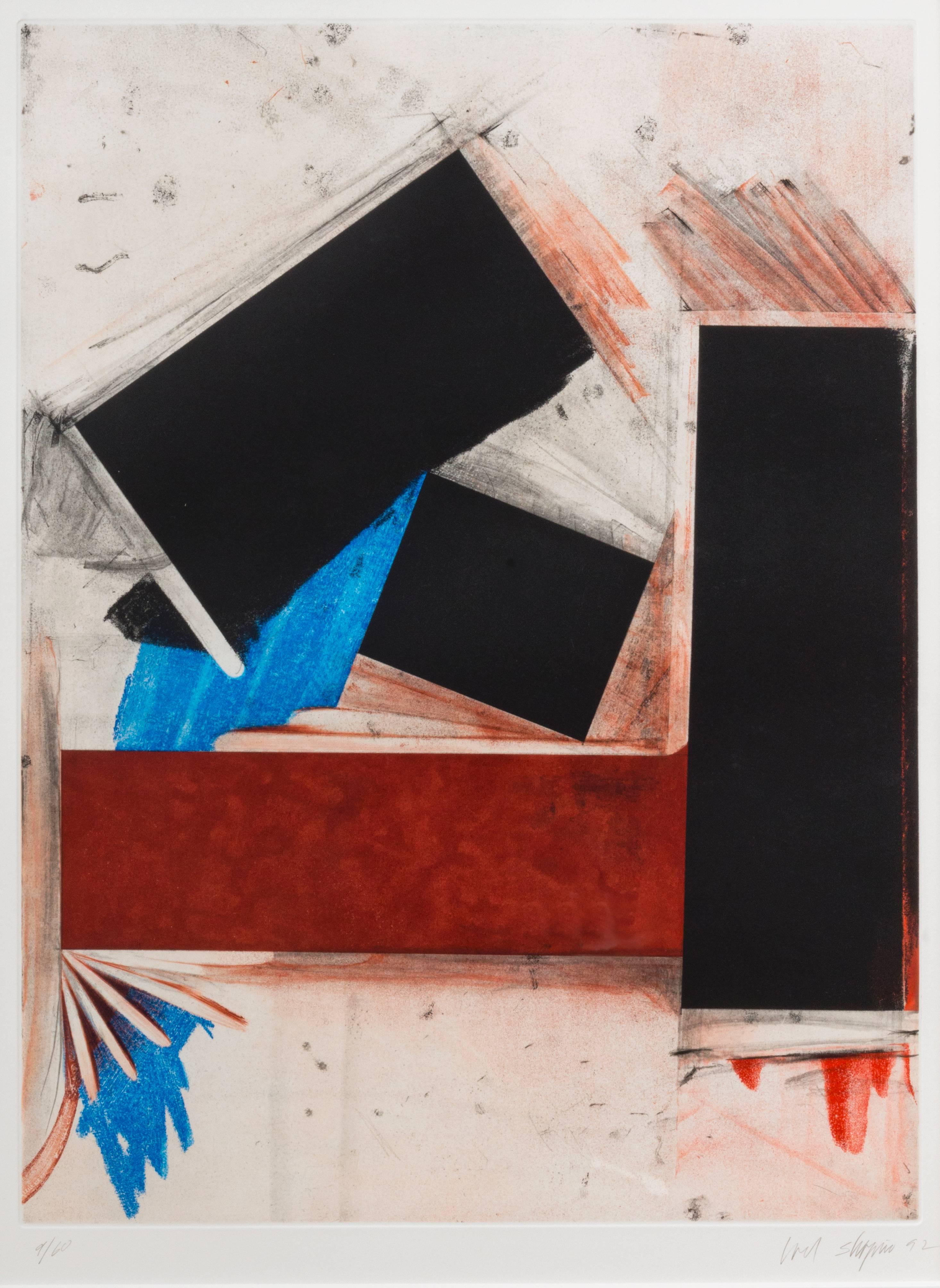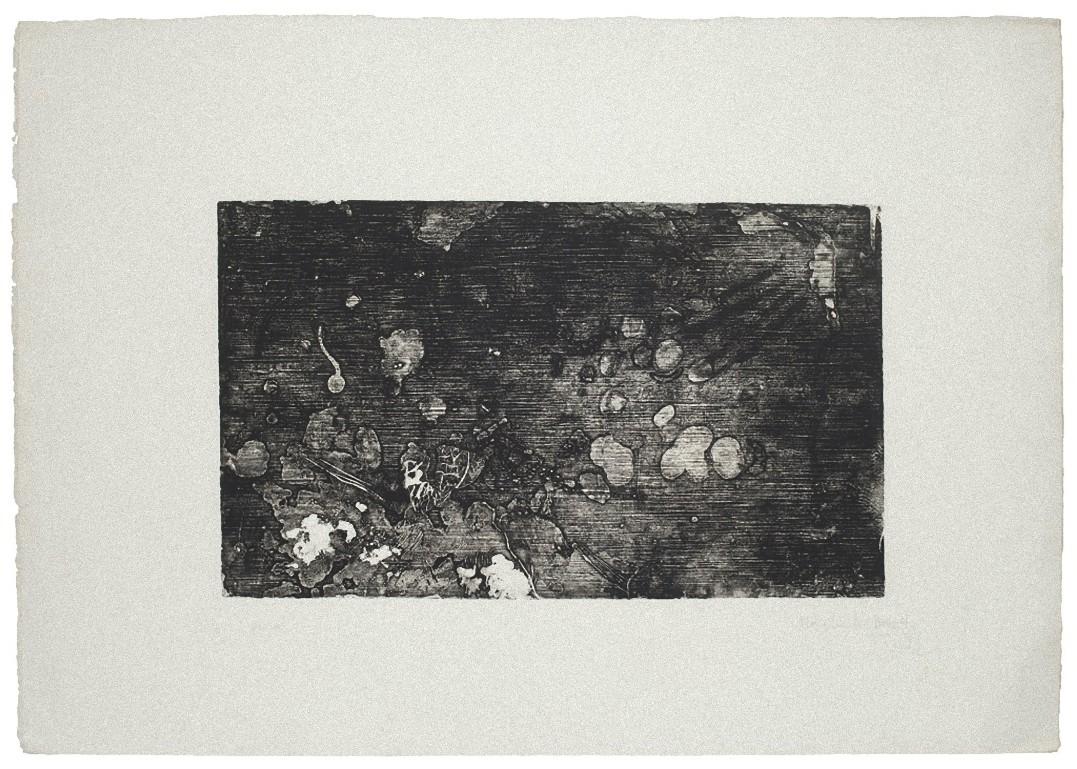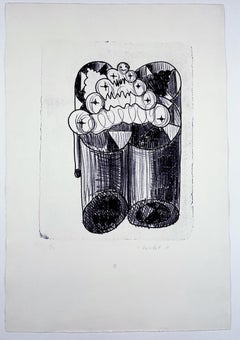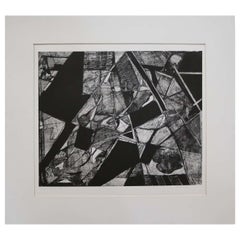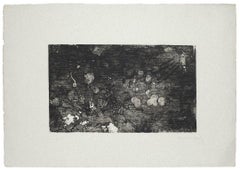Items Similar to A feminine thought Dieter Roth portfolio abstract geometric black white etching
Want more images or videos?
Request additional images or videos from the seller
1 of 22
Dieter RothA feminine thought Dieter Roth portfolio abstract geometric black white etching1971
1971
$3,600
£2,778.42
€3,163.06
CA$5,140.49
A$5,606.71
CHF 2,954.26
MX$67,239.37
NOK 37,197.86
SEK 34,704.85
DKK 23,622.51
About the Item
A Feminine Thought (portfolio), 1971
Plate 11.6 x 9.6 in. / 29.5 x 24.5 cm
Paper 27.2 x 20.9 in. / 69 x 53 cm
2 prints in portfolio with label, intaglio printing (drypoint) in dark green on white handmade paper. Label is offset lithograph on white paper. Signed and dated 71 lower right in pencil. Edition of 50 with 6 artist’s proofs. Printed by Karl Schulz, Braunschweig, and published by Petersburg Press, London.
Dieter Roth’s interest in geometry, transformation, and iteration is on display in this portfolio of two etchings in dark green ink. Each depicts a woman’s figure on all fours, transforming into and from a table, respectively. Each stage of transformation is represented on a new tier: a stepped pyramid, contained by the artist’s precise linework. Behind the stacked figures is a window towards which the woman directs her attention. Equal parts quixotic, whimsical, and disturbing, this portfolio was produced in the early 1970s when Roth was experimenting with similarly tight, curvilinear and geometric forms in their physical environments. Often gridded and bisected by hatched lines, these works are reminiscent of architectural or topographic diagrams.
Condition report:
B: 1-3mm Rust colored stains lower right, upper middle. Edges worn. One 5” and a 1” soft vertical creases lower left corner/left edge, horseshoe crease lower middle, various soft creases throughout sheet especially upper sheet, some waviness upper edge, .5” crease lower right corner, softly creased 1” area middle left edge
A: Lower edge of paper is rippled, various soft creases 1-3” throughout upper sheet and left edge, upper edge is worn and discolored
Dieter Roth was a printmaker from childhood: his first etching at the age of 16 was scratched into a soda can, and despite the failure of the can to print anything but a shadow of ink, he continued his study and by 20 was a serious apprentice in lithography to a well-known commercial artist, Eugen Jordi. Later he would continue to print and publish much of his own work. From the 1960s onward, his collaborations with Petersburg Press brought him international recognition and produced some of his most celebrated work: 6 Piccadillies (1970), and Containers (1972).
Interested in chance and spontaneity, Roth was drawn to make prints using unorthodox means: according to mathematical principles, using equations, or by randomly rearranging blocks before they were run through the press. The artist often printed plates repeatedly in different colors, producing many variations from just a few images. He used the printing press and materials to interrogate the creative process rather than just as tools to achieve an edition of identical prints: for example, overprinting or under-inking, or running objects through the press (in 1968, a box of chocolates). Roth was not just interested in the chance of making pictures but the unpredictability of decay: allowing the grease from slices of meat to slowly contaminate paper, immersing a print in vegetable juice, clamping metal to paper to produce rust, and pouring chocolate over a finished work.
Roth would make hundreds of print editions and books over his career and blurred the line between genres and mediums, embarking on prodigious collaborations and experimentation with music, poetry, art, and literary works.
Condition report:
B: 1-3mm Rust colored stains lower right, upper middle. Edges worn. One 5” and a 1” soft vertical creases lower left corner/left edge, horseshoe crease lower middle, various soft creases throughout sheet especially upper sheet, some waviness upper edge, .5” crease lower right corner, softly creased 1” area middle left edge
A:
Lower edge of paper is rippled, various soft creases 1-3” throughout upper sheet and left edge, upper edge is worn and discolored
- Creator:Dieter Roth (1930-1998, German)
- Creation Year:1971
- Dimensions:Height: 27 in (68.58 cm)Width: 20.9 in (53.09 cm)
- Medium:
- Movement & Style:
- Period:
- Condition:Some creases and discoloration: please see description for a full condition report.
- Gallery Location:New York, NY
- Reference Number:1stDibs: LU1211215867572
About the Seller
5.0
Recognized Seller
These prestigious sellers are industry leaders and represent the highest echelon for item quality and design.
Gold Seller
Premium sellers maintaining a 4.3+ rating and 24-hour response times
Established in 1968
1stDibs seller since 2019
330 sales on 1stDibs
Typical response time: 1 hour
- ShippingRetrieving quote...Shipping from: New York, NY
- Return Policy
More From This Seller
View AllA thought by Dieter Roth abstract geometric black and white etching
By Dieter Roth
Located in New York, NY
Sliced sausage, a fork and knife, a cutting board, and a cow mid-slurp comprise this elegant yet tongue-in-cheek black and white Dieter Roth etching. Diet...
Category
1970s Abstract Abstract Prints
Materials
Drypoint, Etching
A Muse by Dieter Roth set of ten abstract black and white lithographs
By Dieter Roth
Located in New York, NY
This series of abstract black and white Roth prints is full of movement, wildly diverse mark making, visceral, three-dimensional shapes and dynamic sketched lines. The artist worked on the same stone, erasing and adding elements with each step of the process to create a new print. Working on a lithography stone allowed him to scratch away areas with precision, revealing tightly hatched white lines that complement swaths of smokey gray. A Muse reflects Roth’s interest in permutations, decay, and a mathematical approach to making images. Each week the artist created a new variant: the series was originally planned as a set of 52.
Dieter Roth, A Muse 1971-1972
series of 12 prints (this set is an incomplete set of ten prints), lithographs from stone printed in black on white handmade paper
image 18.9 × 14.6 in / 48 x 37 cm paper 30.7 × 20.9 in / 78 x 53 cm
edition of 30 each, numbered and signed, 6 artists copies
this series 1/30
printed by Karl Schulz, Braunschweig and published by Petersburg Press, London
weekly variant printed from the same stone, began October 1971
(52 prints were planned, but only 12 were executed)
Condition: excellent with some dimples and wear commensurate with age
Catalogue Reference: Roth 185-196
Dieter Roth was a printmaker from childhood: his first etching at the age of 16 was scratched into a soda can, and despite the failure of the can to print anything but a shadow of ink, he continued his study and by 20 was a serious apprentice in lithography to a well-known commercial artist, Eugen Jordi. Later he would continue to print and publish much of his own work. From the 1960s onward, his collaborations with Petersburg Press brought him international recognition and produced some of his most celebrated work: Six Piccadillies (1970), and Containers (1972).
Interested in chance and spontaneity, Roth was drawn to make prints using unorthodox means: according to mathematical principles, using equations, or by randomly rearranging blocks before they were run through the press. The artist often printed plates repeatedly in different colors, producing many variations from just a few images. He used the printing press and materials to interrogate the creative process rather than just as tools to achieve an edition of identical prints: for example, overprinting or under-inking, or running objects through the press (in 1968, a box of chocolates). Roth was not just interested in the chance of making pictures but the unpredictability of decay: allowing the grease from slices of meat to slowly contaminate paper, immersing a print in vegetable juice, clamping metal to paper to produce rust, and pouring chocolate over a finished work.
Roth would make hundreds of print editions and books over his career and blurred the line between genres and mediums, embarking on prodigious collaborations and experimentation with music, poetry...
Category
1970s Abstract Abstract Prints
Materials
Lithograph
Untitled by Bruce Nauman abstract black and white drypoint etching 70s
By Bruce Nauman
Located in New York, NY
A moody, evocative black and white abstract etching by pioneer Bruce Nauman.
Bruce Nauman (born December 6, 1941) is an American artist. His practice spans a broad range of media inc...
Category
1970s Abstract Abstract Prints
Materials
Drypoint, Aquatint
Po th A a Vfb (Portrait of the Artist as Vogelfutterbüste) by Dieter Roth
By Dieter Roth
Located in New York, NY
P o th A a Vfb (Portrait of the Artist as Vogelfutterbüste) 1970
Plate 12.4 x 8.6 in. / 31.5 x 22 cm / Paper 30.7 x 21 in. / 78 x 53.5 cm
Intaglio printing (halftone block) in black ...
Category
1970s Abstract Abstract Prints
Materials
Etching
Goodbye Sharpie Dieter Roth black and white geometric abstract print
By Dieter Roth
Located in New York, NY
Dieter Roth
Goodbye Sharpie, 1972
44.5 x 54.3 / 113 x 138 cm
Planographic printing from zinc, white on dyed grey card
Edition of 30, this copy marked "Artist's Copy" and annotated II/IV
Dieter Roth was a printmaker from childhood: his first etching at the age of 16 was scratched into a soda can, and despite the failure of the can to print anything but a shadow of ink, he continued his study and by 20 was a serious apprentice in lithography to a well-known commercial artist, Eugen Jordi. Later he would continue to print and publish much of his own work. From the 1960s onward, his collaborations with Petersburg Press brought him international recognition and produced some of his most celebrated work: Six Piccadillies (1970), and Containers (1972).
Interested in chance and spontaneity, Roth was drawn to make prints using unorthodox means: according to mathematical principles, using equations, or by randomly rearranging blocks before they were run through the press. The artist often printed plates repeatedly in different colors, producing many variations from just a few images. He used the printing press and materials to interrogate the creative process rather than just as tools to achieve an edition of identical prints: for example, overprinting or under-inking, or running objects through the press (in 1968, a box of chocolates). Roth was not just interested in the chance of making pictures but the unpredictability of decay: allowing the grease from slices of meat to slowly contaminate paper, immersing a print in vegetable juice, clamping metal to paper to produce rust, and pouring chocolate over a finished work.
Roth would make hundreds of print editions and books over his career and blurred the line between genres and mediums, embarking on prodigious collaborations and experimentation with music, poetry...
Category
1970s Abstract Abstract Prints
Materials
Lithograph
Wrapper by Dieter Roth abstract pink unique one of a kind print with shimmer
By Dieter Roth
Located in New York, NY
Wrapper, 1971
34 x 39.75 in. / 86.5 x 101 cm
Lithograph (Zinc) in 6 colours, 4 printing forms on white paper.
Edition of 19, numbered and signed, each a unique print, 3 AP.
Numbere...
Category
1970s Abstract Abstract Prints
Materials
Lithograph
You May Also Like
Drypoint Lambda I
By Ron Davis
Located in San Francisco, CA
This artwork titled "Drypoint Lambda I" 1980 is an original etching by noted American artist Ronald Davis, b.1937. It is hand signed, dated and numbered 9/25 in pencil by the artist....
Category
Late 20th Century Abstract Geometric Abstract Prints
Materials
Drypoint, Etching
"Summer Series 2/6" Black and White Abstract Lithograph Signed L. Siekman
Located in Pasadena, CA
An otherworldly greyscale, abstract lithograph signed L. Siekman.
Category
Late 20th Century Abstract Prints and Multiples
Materials
Wood, Paper, Lithograph
$224 Sale Price
20% Off
Joel Shapiro, Untitled, abstract geometric limited edition etching, 1992
By Joel Shapiro
Located in New York, NY
Joel Shapiro's post-minimalist work often references the human body, in a variety of poses, represented by geometric forms. In Untitled, 1992, a rust-red rectangle supports three black rectangles piled at varying angles. The forms have light, sketchy lines around them, reminiscent of Futurist dynamism markings or perhaps a draftsman's study of dimensions. A gelatinous blue form intersects the balanced rectangles, while further blue forms tumble out of a fanned series of black triangles. Shapiro has assembled mechanism, geometry, balance, fluid, solid and motion into this dynamic etching, which was published by Pace Prints...
Category
1990s Abstract Abstract Prints
Materials
Etching, Aquatint
Black and White composition - Etching by Margherita Benetti - 1972
Located in Roma, IT
Black and white composition is a beautiful artwork realized by Margherita Benetti in 1972.
Hand signed and dated in the lower right margin of the plate.
The state of preservation i...
Category
1970s Abstract Abstract Prints
Materials
Etching
Black and White Abstract Figurative Etching Edition 98/200
By Jorge Castillo
Located in Houston, TX
Monochromatic abstract figurative etching by Spanish painter Jorge Castillo. The piece depicts an abstract landscape overlooking an empty view from what appears to be a cave. Figures...
Category
1970s Abstract Abstract Prints
Materials
Etching
Danny Edwards Abstract Black & White Etching C.1989
Located in San Francisco, CA
Danny Edwards Abstract Black & White Etching c.1989
Fine abstract etching by Danny Edwards.
Pencil signed and numbered 2/2 by the artist.
Plate dimensions 23.5 x 20. The frame mea...
Category
1980s Abstract Abstract Prints
Materials
Etching
More Ways To Browse
Chocolate Box
Vintage Meat Slicers
Roth Etching
Welcome Mat
Ace Gallery Poster
Alan Cote
Alan Thompson
Alexander Calder Balloons
Alexander Calder Hand Signed
Alfred MANESSIER On Sale
Andy Warhol Sunset
Art Poster Helen Frankenthaler
Banksy Welcome Mat
Calder Ea
Calder Flowers
Calder Lithograph Balloons
Calder Lithograph Pyramids
Calder Mcgovern
